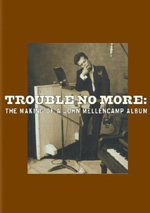|
VENTURA
|

| |
|
MOVIE INFO
|
|
Director:
Ron Osgood
Cast:
John Mellencamp
Synopsis:
A rare look inside the studio during the recording of John Mellencamp's new album, "Trouble No More". Mellencamp's newest work covers a collection of historic blues, folk, and American roots music. With over 120 minutes of footage, the documentary provides an intimate look at the making of the album.
MPAA:
Rated NR
| |
|
DVD DETAILS
|
Presentation:
Widescreen 2.35:1/16x9
Audio:
English Stereo
Subtitles:
None
Not Closed-captioned
Runtime: 53 min.
Price: $14.98
Release Date: 1/13/2004
Bonus:
• Booket
| |
|
EQUIPMENT
|
Sony 36" WEGA KV-36FS12 Monitor; Sony DA333ES Processor/Receiver; Panasonic CV-50 DVD Player using component outputs; Michael Green Revolution Cinema 6i Speakers (all five); Sony SA-WM40 Subwoofer.
| |
|
RELATED REVIEWS
|

| |
[an error occurred while processing this directive]
|
Trouble No More: The Making of a John Mellencamp Album (2003)
|
|
Reviewed by Colin Jacobson (December 8, 2003)
When John Mellencamp decided to record an album mostly of roots music, he brought along a University of Indiana film crew to document the sessions. As a result, we get Trouble No More: The Making of a John Mellencamp Album, a program that gives us a glimpse of the creation of the Trouble No More record.
This mostly follows a conventional format. We see elements of the sessions interspersed with comments from many of the participants. We find remarks from Mellencamp, Columbia Records A&R man Steve Berkowitz, manager Randy Hoffman, publicist Bob Merlis, guitarist Mike Wanchic, engineer Ray Kennedy, guitarist Andy York, violinist Miriam Sturm, vocalists Courtney Kaiser, Pat Peterson, Janas Hoyt, business office manager Tim Elsner, drummer Dane Clark, bassist John Gunnell, Mellencamp.com webmaster Tony Buechler, engineer Paul Mahern, and bassist Toby Myers. In addition, we occasionally get special performances of some Trouble No More songs. These include “Stones in My Passageway”, “Teardrops Will Fall”, “End of the World”, and “Down in the Bottom”.
As for topics discussed, we discover a good array of information connected to the album. We learn about song selection, the 16-track recording and equipment used, recording live in the studio, and various problems and musical decisions. Mellencamp’s Iraq War-related “To Washington” receives particular attention, as we hear of the tune’s exposure and see a little of its web-based video.
Trouble presents a fairly decently look at the recording of the album, though it suffers from some disjointedness. The material doesn’t seem to appear in any particularly coherent order. Instead, the program flits around the sessions seemingly at random. Perhaps the show follows the sessions in the order they were conducted, but I don’t get that feeling. Instead, the elements pop up without much apparent rhyme or reason.
This still gives us a fairly interesting examination of the sessions, though. The best elements reflect creative conflict, as those show more than just the usual “everything’s great” happy talk. The main theme comes from issues with engineer Kennedy. He experiences difficulties that make it tough for him to do his job, and that leads to conflict between him and Mellencamp. Eventually he must replace Kennedy as well. These sections are clearly the most compelling.
Overall, Trouble No More presents a reasonably intriguing snapshot of the recording process. We get a lot of interesting shots from the studio, and these often give us a “fly on the wall” perspective that allows us to glean a nice feel for the process. Trouble seems a little loosely-structured and doesn’t provide an excellent documentary, but it works well for the most part.
|
The DVD Grades: Picture D/ Audio B/ Bonus D-
|
|
Trouble No More: The Making of a John Mellencamp Album appears in an aspect ratio of 1.33:1 on this single-sided, single-layered DVD; due to those dimensions, the image has not been enhanced for 16X9 televisions. The black and white picture demonstrated its videotaped origins in this fairly unattractive presentation.
Sharpness mostly seemed adequate. Much of the time, the show looked acceptably distinct and well defined. However, a moderate amount of softness showed up, as more than a little of the picture came across as somewhat indistinct. Jagged edges were a frequent issue, and I also saw quite a lot of shimmering via the studio walls. A moderate amount of edge enhancement seemed apparent.
Source flaws mostly seemed absent. Some video noise appeared in low-light situations, but they resulted from the original photography. Those issues did become fairly heavy at times, though. Black levels were generally deep and dense, though they came across as a bit murky at times. Contrast was a bit dull, and some shadows looked somewhat flat. Given the nature of the program, the picture never was an issue, but it still appeared pretty ugly much of the time.
Not surprisingly, the stereo soundtrack of Trouble No More seemed more satisfying. Stereo imaging occurred for the music and nothing else. The rest of the time, the sound remained oriented in the center. The music opened things up somewhat, but even those elements failed to deliver great spread and delineation. The songs stayed pretty noticeably aimed in the middle. However, I didn’t regard this as a real issue; for music with a nod toward the past, it made sense for the presentation to come across as somewhat minimal.
Audio quality was solid. Speech mostly sounded natural and warm, though the mix of sources meant that some dialogue was somewhat muddy or a little edgy. Music seemed lively and distinctive. The different instruments were accurate and rich. Highs appeared crisp and concise, and bass response was bold and rich. The scope of the audio remained uneventful, but the music of Trouble No More seemed satisfying.
A very basic disc, Trouble No More comes with almost no supplements. Heck, the disc doesn’t even present chapter stops! The package presents a short booklet that presents a short but informative essay about the creation of the album from Mellencamp’s publicist Bob Merlis.
At times, Trouble No More seems less coherent and cleanly developed than I’d like. Nonetheless, it includes enough good “behind the scenes” footage to make it an interesting document of the album recording process. The program comes across as honest and frank in its depiction of the sessions. The picture quality seems weak due to the source material, whereas audio mostly appears positive. The set includes almost no extras. With a list price of only $14.98, Trouble No More comes cheap enough to merit a look for John Mellencamp fans.
|
|
[an error occurred while processing this directive]
|
|

